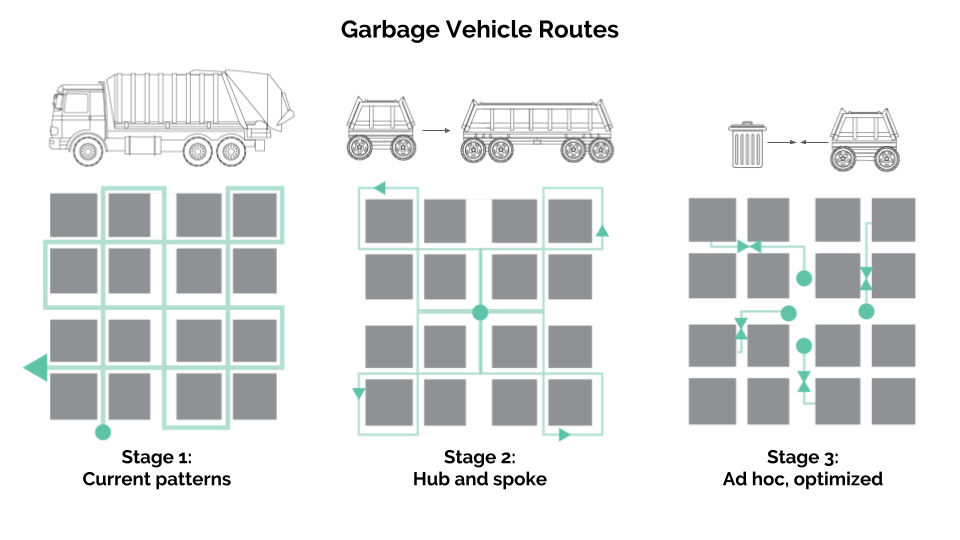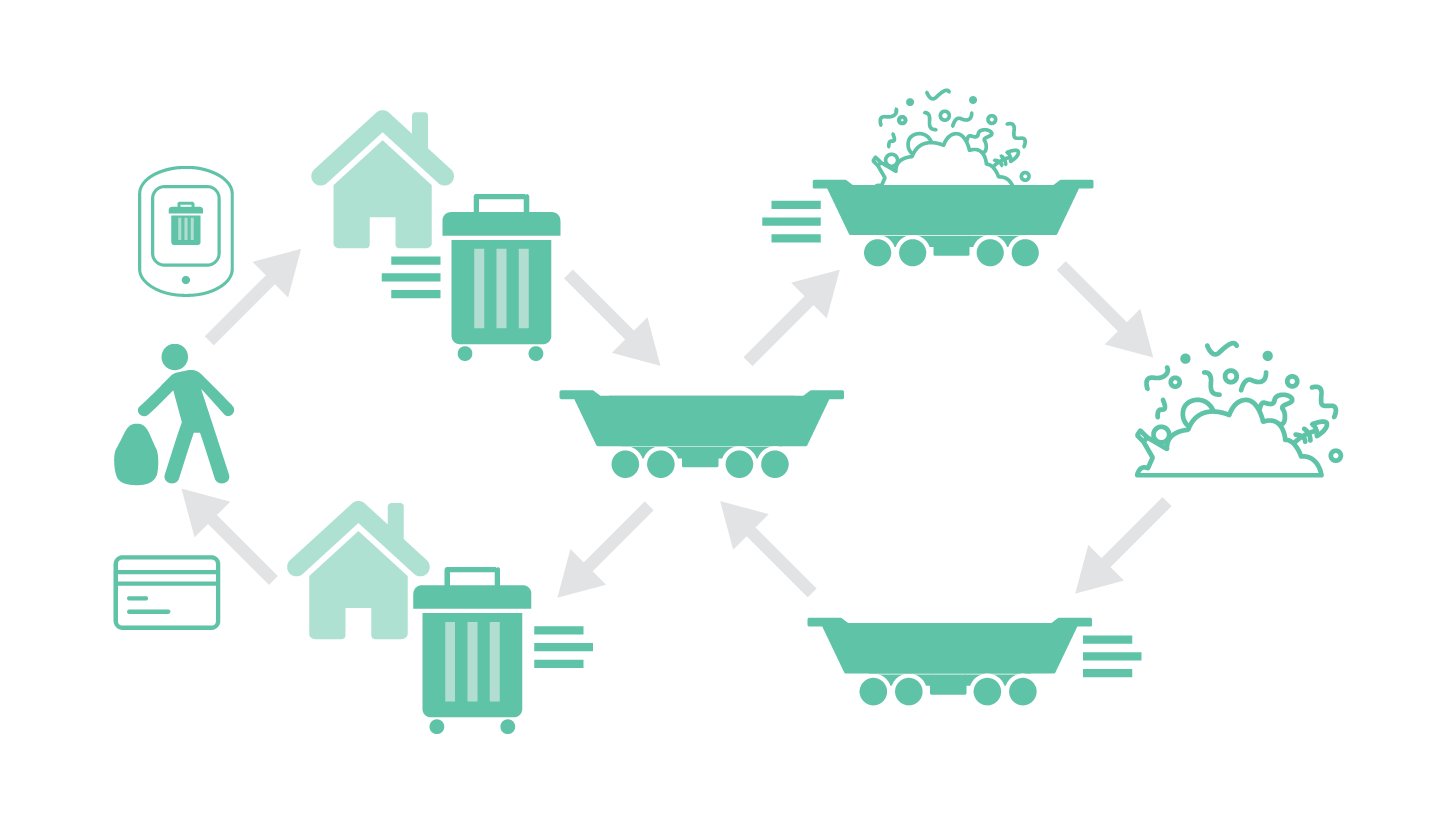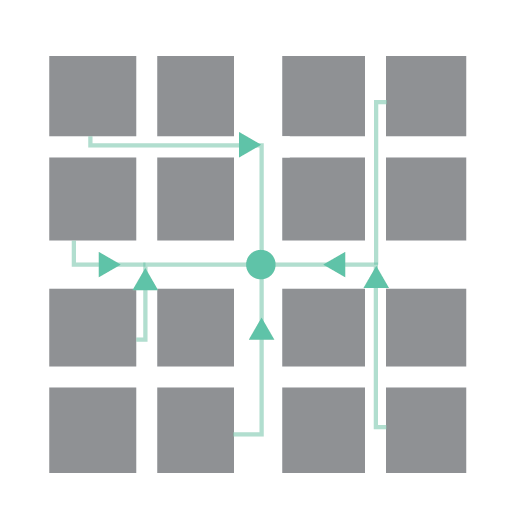
Common issues cited by sanitation workers include street design, trash can design, neighborhood tensions, and weather.
We see a future where AV OEMs partner with city governments to put autonomous vehicle technology to use for the good of the community. Autonomous trash trucks and trash cans can save time by redesigning the routes that trash trucks have to take, restore dignity to the sanitation worker by shifting the nature of his or her job, and ultimately promote sustainability and public health by improving municipal sanitation at large.
We quickly realized that our project is not just about redesigning a trash truck or a trash can, but re-imagining the relationship sanitation workers, citizens, and governments have with trash. We lay out the future we’d like to see in our manifesto.
“They treat us like what they throw out - trash”
In the following sections, we summarize the insights from our observations and interviews with municipal sanitation workers, and address how our solution can mitigate some of the challenges they face.
Our team’s redesigned trash can. We envision this new, wheeled trash can driving itself to a larger truck. The truck will then lift up the can and empty its contents before driving the trash to a landfill.
AV trash cans reduce the need for trash bags
Sanitation workers have several major concerns about the trash can and how people throw out their trash. First, they prefer that residents throw out their trash in bags rather than as individual items directly into the trash can. This is because trash bags can be easily lifted out of the trash can while loose trash necessitates the entire trash can being lifted into the sanitation truck.
removable lids reduce injury risk
The lifting challenge is exacerbated if the trash cans has a lid that is attached to the can. Lifting such a can overhead often leads to the sanitation worker being hit in the head with the lid of the can as it is being lifted. AV trash trucks and trash cans eliminate the need for humans to lift anything, so long as the cans are designed to standards that fit the claws used by trucks to pick them up.
preventing water and ice build-up
Additionally, if the trash can has any residual water at the bottom, it can make it extremely difficult to lift the can. In the winter, this becomes an even greater issue when this residual water freezes at the bottom of the can. One straightforward way this problem can be solved is by drilling holes in the bottom of the trash can.
The sanitation worker’s role
We envision the sanitation worker’s role evolving from someone who lifts to someone who oversees. Inevitably, the trash can will make mistakes in the beginning. Trash will fall out. The sanitation worker’s role will be to perform maintenance on the AV trash trucks and AV trash cans, to clean up trash that falls out, and to execute city beautification projects in the mean time.
Challenges that sanitation workers deal with when working with existing trash cans.
sanitation workers face constant hiv risk
Sanitation workers are always worried about what they will find in the trash. One common concern is that a used syringe will be sticking out of the bag and that this syringe will accidentally nick them. Whenever a sanitation worker is struck by a syringe, they have to undergo thorough HIV testing which can be cumbersome and nerve racking to access. Again, by automating the lifting of trash, we remove this risk for sanitation workers.
trash comes in unexpected shapes and sizes
Additionally, there is huge uncertainty with respect to the size and weight of the items found in trash. Sanitation workers are especially concerned about bulky or large items such as mattresses or tires as they are hard to maneuver and throw away.
The diagrams above show our proposed evolution of trash truck routes as autonomous technology allows the truck to evolve from an over-sized vehicle driving each street by columns and rows, to a hub an spoke system as the vehicles get smaller, to finally an ad-hoc route system determined by trash removal needs. When the trash can itself becomes an autonomous vehicle to transport waste, it can navigate increasingly narrow paths to move waste from residences to the large vehicles waiting outside neighborhoods. Those large vehicles (which currently have to navigate residential streets) will only have to carry trash from less dense areas to the landfills.
Challenges Posed By The Streets
Narrow streets
The design of the street and density of houses can hinder efficient trash pick-up. Narrow streets are more difficult to navigate in a Sanitation Vehicle. Our design starts with an autonomous trash truck akin to those used in Barcelona today, but in later stages, we envision autonomous trash cans driving themselves to meet the larger trucks outside of narrow, residential areas.
dense housing
Streets with a high density of housing units requires more frequent stops to pick-up resulting in the vehicle taking more time to pick up trash. Again, in the final stage of our design, autonomous trash cans will take themselves to pick-up points where larger trucks will collect the garbage and drive it to landfills.
on-street parking
The presence of on-street parking poses several challenges to sanitation workers. Not only are workers concerned about hitting a parked vehicle in the narrow street environment, it can also be cumbersome to pick up trash when it is lost in between parked cars. With smaller, autonomous trash cans, the role of the sanitation worker will shift from trash collector to city beautification expert.
“I live to see people change their habits, see them treat their street and their city with respect.”
Racial Tension
Sanitation workers feel that not all neighborhoods view the worker as a whole person, rather just as the function they perform. In these neighborhoods, it is hard for them to feel respected and valued. This feeling is exacerbated by the fact that the sanitation work force is predominantly black while the constituents they serve range from multiracial neighbourhoods to neighbourhoods that are majority white. While we don’t think we can solve racial tensions with autonomous trash trucks, we do see an opportunity to create small interventions, such as thoughtful messages on the trash trucks that might subvert some of the assumptions around sanitation workers. We hope to remind residents that the people working the streets are part of the community as well.
Dealer Conflict
In certain neighborhoods, drug dealers use trash cans to store drugs and avoid police detection. In these neighborhoods, sanitation workers are harassed by these dealers when they come to empty trash cans used for this purpose.
Lack of Trust in Gov’t
In many communities, sanitation workers are viewed as an extension of a Government that residents believe is not working on their behalf. This mistrust of government leads residents in these communities to treat sanitation workers poorly, when these workers are just trying to protect public health.
One of the strongest indicators of a hard day for sanitation workers is bad weather. It is very difficult to lug trash around on hot and or rainy days. The most difficult days, however, are when it is snowing. On snowy days, it is often unsafe for workers to come out because the streets are slippery. Ironically, these very same workers are also tasked with snow removal and therefore have to not only collect trash on the most dangerous days of the year but also remove snow and make the streets safer for fellow citizens.
Our combination of automated vehicle + standardized trash can allows human workers to take on the role of overseer, making sure trucks are performing as needed and spot-checking for mistakes, as opposed to lifting heavy trash bags in the heat and snow.
“When the sun shines, we shine together.”





















